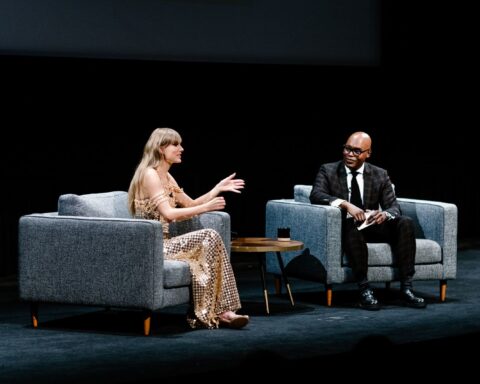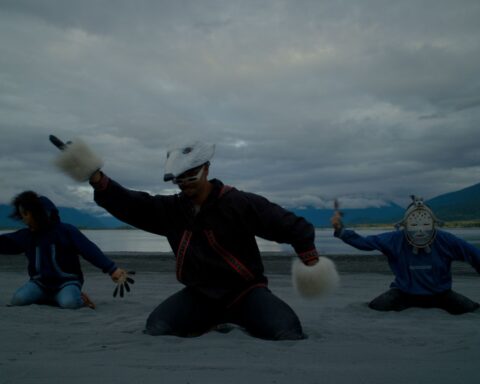I woke up with a start. The first thing I saw was that the windows were foggy. Where was I? In my car? Why? Not because I usually sleep in my car and not because I’m a detective on the lookout but because I was on a mission to capture on film the late-afternoon destruction of perfectly livable housing in my neighbourhood.
I rolled down the passenger side window to get a breath of fresh air. At a distance of at least a full city block, huge excavators were feeding a grinder the size of a semi-trailer with broken shards of social housing: porches, walls, doors, floors, window frames, bathrooms, living rooms, dining rooms, bedrooms and rooftops. They formed a low mountain range across the broken and devastated landscape. A steel conveyor belt slowly drew the mess into an open jaw that consumed it.
It was December 2009 and this was the death of Little Mountain Housing, British Columbia’s first and most successful social housing project. Out the ass-end of the crusher flew a continuous stream of ground wood, paint chips, nails and crushed glass—a substance that the contractor proudly referred to as a “green” and reusable product.
I was anxious and tired. I had fallen asleep waiting for demolition to begin on the buildings next to where I had parked but the buildings were still standing and the newspaper I was reading was crumpled in my lap. But I didn’t live in social housing. I had a comfortable home not more than five blocks away.
My reasons for being here stemmed from decisions I had made three years previously when—after some soul-searching about my documentary practice—I wrote a five-point public declaration and called it The Six-Block Manifesto.
In 2006, my daughter was four years old and my wife was pregnant with our second child. Staying in Vancouver for my son’s birth and to be a supportive partner to my wife during the newborn’s early years had become a priority to me. I wanted to spend less time travelling for work and more time working from home. At the same time it was clear that the renaissance of the Canadian independent documentary was at an end. In spite of the success of my previous films (Drawing Out the Demons, Juicy Danger Meets Burning Man), it was obvious that the route to funding those types of films had all but disappeared. All around me, colleagues were closing their offices and leaving the business while, curiously, the largest film production companies were flush with cash for reality TV.
In order to continue directing, it had become obvious that I would have to leave independent filmmaking and compete for jobs in reality TV; or spend large amounts of time and money (that I did not have) on foreign travel in search of fundable international documentary subjects; or continue a Quixotic quest for non-extant Canadian financing for documentary films. The world seemed to be aiming me in a new and opposite direction. To clarify that direction, I decided to give it a form. That form was The Six-Block Manifesto.
I will look no further than a six-block radius from my home to find subjects for my films;
I will own all of my production and post-production equipment;
I will take the responsibility of shooting and editing most, if not all, of my documentary media;
I will not allow a deficiency of financing to interrupt the production process, nor hinder post-production processes;
I will retain creative control.
This simple and very broad set of rules would compel me to prove my hypothesis: that within a walkable radius from my home I could find compelling stories to tell, which would deepen my relationship to the place in which I live.
Two years after I wrote the manifesto, it came to my attention that the Little Mountain housing project was in trouble. In March 2007, the Government of B.C. announced that it was going to sell and demolish it, and promptly began to relocate tenants. Many of the over 700 residents acquiesced and moved to other social housing units scattered across Vancouver’s Lower Mainland. Others, however, resisted relocation. Community advocacy groups supported them in their fight to “Save Little Mountain,” and began to appear on TV news programmes.
Coincidentally, two old friends who had grown up near Little Mountain tried to convince me to make a documentary about it. Their arm-twisting succeeded and on September 8, 2008, after dropping off my kids at school and daycare, I walked there. Little Mountain was strangely empty except for the wildlife. A grouping of unadorned two- and three-storey buildings framed a flock of Canada geese that occupied the lush central lawn. Above their honking and sputtering I could hear a young girl’s voice emanating from an open door in a row house. Her father was the first resident with whom I spoke. He offered to tell me why he opposed B.C. Housing and why he was not going to leave without a fight. As he spoke, I began to imagine what the first documentary to test my manifesto might look like.
October 2009. I climbed out of my car and walked out into a cold and steady drizzle. The row houses had been gutted. My appearance with camera in hand on the public side of the chain-link fence usually coincided with a retreat of all heavy machinery from the area. The operators found it unnerving to be on camera as they destroyed social housing and had told me so. I tried to reassure them that I understood, and that as much as possible I would obscure their identities in the final documentary product—but I would not stop filming.
Through the fence I could see mashing and grinding at a distance, but I had already shot enough of that. It was the three remaining buildings on this corner that were my focus, because one of them had previously housed Sammy and Joan Chang, an elderly blind couple. Sammy and Joan were two of only a handful of Little Mountain tenants who had fought for and won the right to relocate to a group of row houses in one corner of the 15-acre property. They were central characters in the documentary that I was slowly and painstakingly recording, and I wanted to catch the demolition of their building, and the destruction of Sammy’s award-winning vegetable garden. It was possible that the demolition crew had recognized my automobile and had avoided the area. As dusk fell, one by one, the machines ceased their activities and the workers left. I got into my car and drove home.
Six months later all but one of the original 45 buildings had been ground into “fertilizer.” In the last remaining row house resided the last three families who had successfully fought against relocation. They included Sammy and Joan; Ingrid Steenhuisen (principal community organizer of the tenants’ resistance) and her aging mother; and a feisty optimist named Karin Nicholetti, who shared a place with her cat. These three families had asserted their right to question and resist the wanton destruction of their community, even if the community only amounted to a single row house. If I wanted to complete my documentary about Little Mountain with a bittersweet ending, this was the time to do it.
There was, however, a new process evolving, one that would change the length and depth of my engagement and my role in this community’s evolution. The City of Vancouver had called for the creation of the Little Mountain Advisory Group, an assembly of community members who would regularly and voluntarily meet to consult with planners, architects and the developer on the redevelopment of Little Mountain. If I chose to delay the completion of the documentary, I could place renewed energies into recording a significant public consultation process.
I had to question myself. Was my aim to produce a single documentary film based on 18 months of observations, or to explore film and community engagement? Was I more interested in process or product? Was my role better defined as an observer or active participant, and how long would I be able to sustain the practice?
And this is how I became a kind of unpaid civil servant. I got used to taking centre stage at every meeting of the Little Mountain Advisory Group to explain what I was doing and why, and to ask whether anyone objected to being recorded by my camera. Planners, architects and developers have a certain authority in these kinds of civic undertakings but my authority came from my neighbours, who felt empowered by my attendance. And I was expected to attend every meeting. Once, I arrived late, and even the architect, James Cheng, expressed concern. He, too, celebrated the concept. He told me that he had never heard of a planning process of a major civic project being scrutinized in such a close and comprehensive way.
But I wasn’t at those meetings just to create the most thoroughly researched documentary on a major civic redevelopment process ever made. The city promised that a state-of-the-art community, embracing the most enlightened thought on community arts, culture, childcare, seniors living and public realm, would be built within six blocks of my home, upon the ruins of Canada’s social housing legacy—and I was going to make damned sure that they did it.
That same year I also decided to return to graduate school to get a better grasp of my undertaking, within the context of neo-liberalism, art and activism, the history of documentary film and the evolution of the Internet and the public sphere. At Emily Carr University of Art + Design, I was asked to explain how and why the work was of benefit to the community. I realized that the media I was collecting had to reach its audience in a timely fashion to be of relevance to the ongoing social and political process so I launched the website of the Little Mountain Project.
I built the website on a WordPress platform. Visitors to the site land on a homepage, where they can choose to read the current blog and watch the latest video, or select from options presented on the header or menu. The header provides context for the project such as history, filmmaker’s bio, press coverage and exhibitions, as well as information about upcoming iterations of the Little Mountain Project. It also provides access to the extensive video archive of over 55 videos—as of this printing, the menu and blogroll provide access to every posting since the website was created.
I endeavour to stream every meeting and public forum of relevance to the Little Mountain redevelopment on the site soon after it takes place. Accompanying each one is a blog entry situating it within the series and highlighting significant details. I reveal my bias through my writing, but the content of each meeting is impartially recorded and uploaded in its entirety. Some videos are accompanied by “highlights” clips of five to 10 minutes in length. They provide a quick overview of a particular meeting but, as filmmakers make editorial choices, these cuts reflect my personal point of view. The community is free to add commentaries about the process.
Although my tools are up to date, my process isn’t original. People have engaged in media production for the purpose of community empowerment since long before me. The National Film Board did it from 1967 to 1980, in a programme called Challenge for Change (CFC). (It’s well documented in a must-read anthology titled Challenge for Change: Activist Documentary at the National Film Board of Canada.) Colin Low was the director of the first CFC project shot on Fogo Island. In 1967, Low filmed interviews with different members of each community, screened the rushes back to the community for approval, then to other communities on the island. Through this process, Low discovered that “the media could be made to function as a collective mirror, enabling communities to view themselves, discover their strengths and bring their ideas to better order.” Dorothy Todd Hénault and Bonnie Sher Klein gave port-a-pack video systems to members of an impoverished Montreal neighbourhood and asked them to record themselves. When viewed on closed-circuit television, the community of St. Jacques recognized their common problems and began to talk about joint solutions.
Compare those words with the statement of values of The Rapidian, a hyperlocal website serving the community of Grand Rapids, Mich., now. It becomes clear that the hyperlocal is a re-invention of the values of the Challenge for Change programme: “The Rapidian has been designed with a local focus… The Rapidian is for the purpose of helping our community better know itself… The Rapidian is an experiment intended to demonstrate that as community, we can use the concepts and structures of citizen journalism to share information, empower new voices and increase meaningful interaction between all of us…”
When I launched littlemountainproject.com, documentary filmmaking had not yet fully digested the implications of new technology—websites, webdocs, hyperlinked videos and text—in the terms of the CFC model. In order to serve my own specific needs at Little Mountain, I named my project the “hyperlocal documentary.” While “Six-Block Manifesto” did entail a local filmmaking methodology, it did not constitute a hyperlocal documentary practice until it was connected to a dissemination, distribution or exhibition process that was based in the Internet. As long as the filmmaking process was exclusively connected to the production of a conventional documentary for standard release (be it on festival screens, through theatrical distribution, or on TV), it would have essentially remained local filmmaking. The documentary process for Little Mountain project became hyperlocal when the community of the housing project and the community who surrounded it, who were the subjects of the media production process, were identified as the target audience for the project—and when I, as a filmmaker, began communicating with them directly through the Internet.
The hyperlocal documentary combines a number of elements: local geography, Internet accessibility and timeliness. But there’s a fourth element: the notion of duration of process, one that returns to the root of the documentary project, the anthropological concept of the participant-observer. The Little Mountain project is based on the premise that patterns of human thought and activity become more apparent when viewed over broad passages of time. This became clear during Little Mountain’s second great eviction crisis.
The idea that a handful of tenants could block the demolition juggernaut of 2009 must have infuriated the B.C. ministry responsible for Housing. In the summer of 2012, they delivered to the residents their final and uncontestable eviction notice. It was alarming and demoralizing for the tenants at Little Mountain. Of immediate concern were the health and well-being of Sammy and Joan Chang. In 2012, a tragic accident robbed Sammy of his remaining eyesight. Completely blind, Sammy was stressed and highly vulnerable. He no longer had the energy or the tenacity to oppose B.C. Housing and the Province of B.C. To make matters worse, the eviction was to take place on very nearly the same date as surgery on his injured eye. Both Sammy and Joan were desperate.
In response, core members of the community combined forces: press conferences were given and rallies organized. I hastily compiled six short films from my raw footage and liaised with members of the Vancouver Renters’ Union (an advocacy group fighting reno-evictions and homelessness) in order to screen them in bookshops, community halls and cinemas and I called my press agent, who organised interviews for me in newspapers and on radio.
John Grierson was famously known to say that if he could get the right dozen people into a screening room to see a film he was happy. With these words in mind, I scheduled myself into a speaker’s slot at a city council meeting on Oct. 3, 2012, in order to demonstrate to the mayor and council the human side of the eviction story. I had five minutes for my entire presentation, and chose to screen one unfinished film. It was titled The Eviction of Sammy and Joan, and in it was footage from four years of vérité documentary shooting at Little Mountain including the demolition of their first apartment, which I’d taken great pains to capture. I remarked that the film was having a strong emotional impact at community screenings, but wondered if it would fare as well in the chambers of civic power. That afternoon, after the screening, there were no new motions passed on the subject of the evictions and the mayor politely listened to two additional speakers (Ingrid Steenhuisen and David Chudnovsky) who stated our case. At the end of the council meeting, I was taken aside by one of the councillors, who told me that in all of her years at city hall, she had never heard the room fall as thoroughly and uncomfortably silent as the moments following the end of my film. It had demonstrated, as she put it, the “power of art.”
The eviction notice was defeated. Significant in our victory was the promise by civic and provincial government to fast-track the construction of 53 new social housing units, expressly for the use of senior citizens, and way ahead of any other site construction. Once completed, Sammy and Joan will only be required to walk to a newly constructed building on the other side of the property.
Challenge for Change was an experiment that revised the filmmaking process by taking the “artist” out of the programme. The tension between the filmmaker as artist and as community facilitator increased when documentary directors followed up their participatory processes with theatrical films. In the case of the Little Mountain project, process and product are intimately intertwined. Though conceived as long-term vérité filmmaking and partially funded by the Arts Council of B.C., the Little Mountain project has gone far beyond its earliest ambitions, but the feature documentary is still an important element in the process of making the work public.
From local to hyperlocal to civic to provincial to national, our significant victory of last year only made it clearer to me that the Little Mountain project is not of exclusive interest to my community. It speaks to national concerns. The story and the dialogues around it must spread further, to include the debate on the lack of a national housing strategy in Canada. A feature documentary release would be useful at this point, orchestrated with an expansion of complementary Internet or transmedia initiatives.
In May of 2013, I will find myself at the Hot Docs Forum, pitching the project to public broadcasters from all points in North America or Europe. Why? To leave no stone unturned. Will the feature documentary No Place Like Home: A Film About the Little Mountain Housing Project, based on the five years of observations, find a broadcaster? Or is crowdsourcing to be the answer to its financing? Only time will tell.











